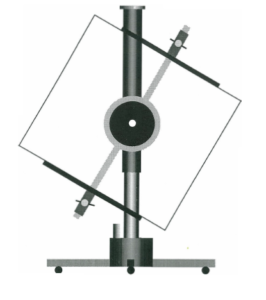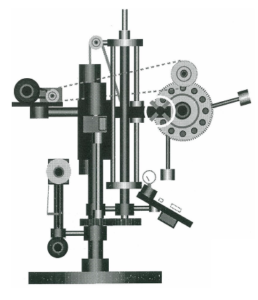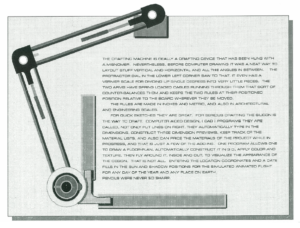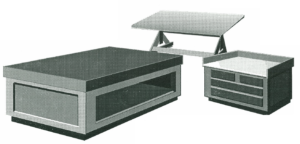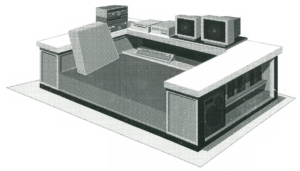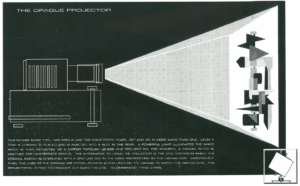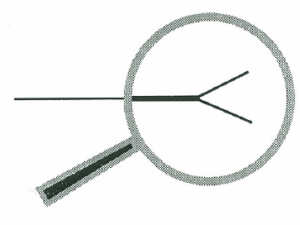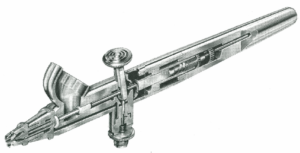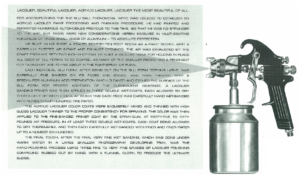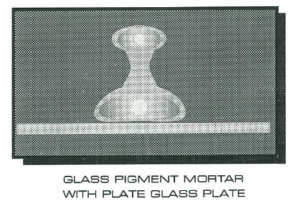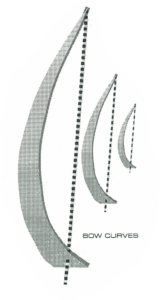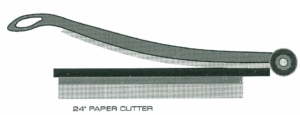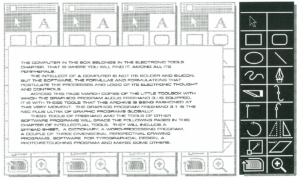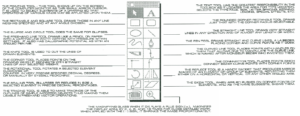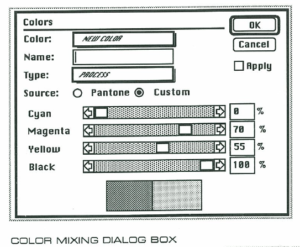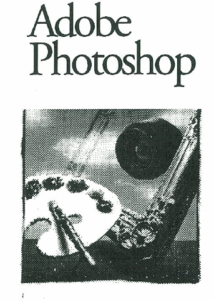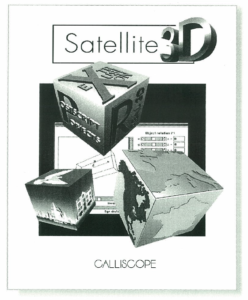Art / Drawings
ART AND DRAWING TOOLS
CHAPTER SEVEN VOLUME TWO BOOK THREE 1924-1994
Chapter seven points at, and illustriously illustrates, a selection of -tools used by the artist in creating not only art but machine design, building design, illusions. Furniture, printing’. Design and publications, among all kinds of other stuff. Hardware, from a steel air, operated voice-controlled artists easel.to complex computer drawing program software. And a miscellany of neat miscellaneous stuff all make it onto these pages.
THE VOICE ACTUATED/ AIR OPERATED PIVOTING ARTIST’S EASEL
The voice actuated/ air operated pivoting artist’s easel goes way back in its origins to an oaken / birch easel that was designed and built in 1954.
The genre of abstract painting being painted in 1954 was such that it was necessary to paint solid color blocks of color up to and along a line. To paint the lower edge of a shape it was necessary to remove the painting from the easel, turn it one-eighty, and then remount it on the easel.
Obviously an invention was called for. In oak and birch the easel was built that pivoted the work. There was an additional addition added besides. The pivoting section was made to move up and down on a counter-balanced cable, as well as rotating to any desired position. It worked just fine.
In 1993 Louisville’s most noted sculptor, one J. Barney bright, was working on some large and heavy clay models which required raising and lowering the rather primitive modelling stand. He needed an air assist. It was built and lives to this day.
If Louisville’s most noted sculptor could have an air assist, Louisville’s most private painter would certainly deserve an air operated easel. It was built and lives to this day.
An air cylinder with a thirty-six-inch shaft is mounted inside a five-foot-long cylindrical steel tube which has been machined on the lathe to fit inside a second steel tube which carries the pivoting mounting arms of the easel. The voice actuation permits the artist to control up, down, and stop controls by voice command.
Say “up”, the easel answers “beep” and the air cylinder lifts the painting until “stop” is pronounced -same with down.
Neat.
THE PRECESSING ELLIPTICAL PROGRESSIVE RADII SPIRAL DRAFTING MACHINE
The above named machine was another topsy adventure.
Being quite caught up in spirals, what with making thousands of them every year of aluminum, it occurred to me that a painting in tribute to the unique geometrid beauty of the siralling form would in effect be a fitting tribute to it.
But there was a catch wherein lay the rub. To draw a big perfect spiral by eyeball is no mean feat. There must be a better way, wrapping strings around a post wasn’t the answer. With a machine shop at hand steel would do it
What started as a simple concert propelling a marker along a long screw as it moves up a rotating surface would do it just fine.
And it did. But. But it seemed a shame to stop there. So a few weeks later the precessing elliptical spiral drafting was completed. It operates on four separate electric motors, has two infinitely variable gearboxes, chain and sprocket T and gear tooth drives, a pressure regulated airbrush painting tool, and a forty by sixty inch rotating drawing board: clockwise or counter-clockwise
If all this talk seems familiar, it is because chapter three page nine B, said the same thing. For a discussion of the machine operations go back and read chapter three, page nine B. For a glimse of the art the contraption makes, check out chapter one, Art
THE DIETZGEN DRAFTING MACHINE
STUDIO FURNITURE FOR LAYOUT, DRAFTING, AND PAINTING
THE DRAWING TABLE
The drawing table, when fitted with the drafting machine device has seen many strange and wonderful designs taped td its surface including the very studio plans for the studio in which it resides.
THE PALETTE TABLE
The little chest of drawers, now palette table, has been in attendance since 1930 on boulevard napoleon. It was rebuilt as a palette table in 1853 and has seen serious duty since as a container for oil colors and brushes, for storage of drawings and preliminary color sketches, and as a cache of all sorts of art papers. Its top is plate-glass over a white surface. Mounted on caster wheels, it follows the voice operated easel wherever it sets up shop.
THE LAYOUT TABLE
The layout table, six by eight feet of steel and plywood and black Formica, was built in-house in 1985. Its large underbelly stores large sheets of paper, canvas, and aluminum, among other kinds of oversize stuff. Its large black Formica surface is always involved in some sort of major project. Life could not go on without it.
THE SARCOPHACOUCH
The sarcophacouch has developed over the years from a simple palette to lie upon to the electronic marvel which it has become. The artist has always preferred a reclining position for creative endeavor. The advent gf computer art made this preference mandatory. Hours and hours at a desk making art won’t fly. This couch of steel, Formica, plywood and foam was also built in-house in 1885. It supports the Macintosh computer, two monitors mounted on a pivoting plank. The digital scanner, the external hard drive, audio hi-fidelity components, speakers, bookshelves and the body of the artist and his hound-dog.
ARTIST’S BRUSHES / WHITE BRISTLE FLATS
The brushes represented on this page would represent only a small fraction of the great variety of styles and variations of artists brushes for all sorts of various uses in the painter’s art of yesteryear and this year as well. Yet, there they are, called flats’, as they are designated in the trade, brushes made from the white bristles of white Chinese hog’s backs, plucked and separated by length, graded in quality, and then carefully fitted into ferrules in such a way that the natural curve of each bristle joins the others to form a permanent chisel tip. A spread of sizes from one-quarter inch wide to an inch and a quarter sufficed the artist for all his paint brushing years.
The diagram at the left magnifies the tip of a Chinese hog bristle showing the delicate natural forking of the end of the hair which is critical to the feel and function of a brush used in applying oil colors to canvas. This minute bifurcation is directly responsible for the existence and raison d’etre of the lion company and the silicoil brush cleaning enterprise. It was to protect from damage these delicate forked hairs, known as ‘flags’ in the trade, that the silicoil brush cleaning tank was designed. The coil screen of the tank doesn’t harm the flags, brushes remain flagged, and the world is a slightly better place for it. See volume three for a more detailed expostion of the silicoil phenomenon.
THE AIR BRUSH
The sliced down the middle airbrush pictured here pictures the precision complexity of modern art tools. For the precessing progressive radii elliptical drafting machine, [ which see], a modern art tool was just the ticket. To apply color with a pen, ballpoint, or otherwise, was not possible on a surface rotating at many feet per minute. The airbrush could provide a continous flow of color quite easily. It also made available variations in color density and line width by varying air
Pressure and brush-to-surface distance. For the slueball project, [ which see], the airbrush would have been insufficient. Industrial spray-painting equipment was required. The following page speaks on that subject.
LACQUER SPRAY-PAINTING TOOLS
MISCELLANEOUS DRAWING AND DRAFTING TOOLS
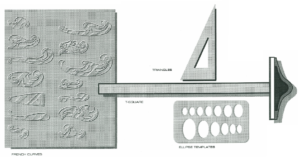
A token representation is here made of some of the antique tools used during the artist’s years of ancient technology. Any time before 1990 must now be referred to as antiquity when speaking of drafting technology after the flowering of the silicon garden. These tools are kept as artifacts, reminders of a simpler age. Nevertheless, a lot of good stuff got drawn with such primitive tools. They deserve our veneration.
MISCELLANEOUS ART AND DRAWING TOOLS
The tools on this page are involved with real material things in the art of art. The bow curves were contrived by the artist as sort of giant French curves for drawing irregular curves on large canvases. By tightening or loosening the chain bowstring any geometry of a curve may be produced.
The ponce wheel, a tool also used in the fabric world, is used to trace large Marquette’s of paintings or murals by perforating a line and dusting it with powdered charcoal through and onto the painting surface.
For many years the artist ground his own oil colors from raw pigments and wed them to linseed oil with the glass mortar and plate. Color quality was thus assured. The paper cutter has been used almost everyday for forty years for something or other. Beats scissors.
ART AND DRAWING TOOLS / SOFTWARE
ALDUS FREEHAND DRAWING SOFTWARE VERSION :3.1
As indicated on the previous page of this opus, software was the subject and freehand was its name. Freehand is one of three or four vector drawing programs differing from a bunch of what are known as paint programs. The paint programs deal with bitmaps, clusters of pixels or points of light when seen on a screen or printed. Vector drawing programs work with lines and shapes drawn by lines which are encoded vectorally. The placement of these lines and their vectorization is done with the tools represented by the ikons in the toolbox shown here on this very page. As that is where things begin to make the art, let it therefore begin there.
As indicated on the previous page of this opus, the freehand description was to continue. Continue it will. With the mechanics of drawing revealed the marvels of color should be exposed next. Freehand permits, through its color mixing dialog box, the mixing of one hundred million discrete colors. As may be seen and multiplied, colors modified by the slide bars in one percent increments would give 100 x 100 x 100 x 100 equaling 100,000,000. The color monitor is capable of displaying 134,000,000. Nothing is perfect, anymore.
With this many colors at hand the artist is truly embarrassed by choice. On screen, with the brightness turned up, the impact is non-plussing, to say the most. The darks are deep, the high-lights sparkle, the gradations of colors in blends are smooth and subtle because there are millions of colors possible in the display. Millions of colors encoded by the freehand program in untold numbers of 1111111’s and 00000000’s.
The freehand program does much more than furnish the artist tools to create images, which is already wow. There are many features related to the printing and publishing arts. Setting of text in limitless choices of typographic fonts of type, automatic color separation for color printing on the presses of the printing trade, importing and exporting of material from and to other computer applications, etc., not to mention the design and execution of this major historical archival publication at hand.
A more detailed exposition of the application of the talents of these designers of Aldus freehand is to be found in the chapters dealing with art and the computer in these pages.
Aldus is named for Aldus Manutius, famous printer, (1450 -1515), who in 1498 established a printing and publishing company in Venice to publish Latin and Greek classics. In so doing he contributed majorally to the cultural and intellectual renaissance of western civilization.
Maybe a little heavy for freehand, but at least they are trying.
PHOTOSHOP/AN IMAGE ENHANCEMENT PROGRAM
As can be comprehended by perusing the toolbox of this gigantic program, Photoshop is no child’s play, but the ultimate in image processing. It is not truly a drawing tool in the sense those words are being offered here, but is an adjunct, an accessory. To those tools that are truly.
Images, (photographs, engravings, wood cuts, printed materials, and the like), which are brought into the computer must be processed to fit the specific role they are to play. Photoshop does many things to an image to make it sing in tune. It darkens/ lightens, sharpens/ blurs, it enlarges/ shrinks, it colors and discolors and does many unmentionable weird things which will not be mentioned here. Without Photoshop, scanning would be unthinkable and probably unusable.
SATELLITE 3D SOFTWARE
The satellite three-D application program was developed by jean Philippe le-seigleur as an ingenious tool for computer graphic artists with which to create perspectival images without submitting themselves to the rigeurs of multi-vanishing point perspectival construction.
Wrye, in developing the slu cube illusion recognized early-on the potential of the computer for the digital enhancement of the slu cube illusion both in rendering text in perspective and graphic images as well. Satellite 3-D was the perfect combination.
After designing the slu cube graphic in two dimensions on the computer in the freehand graphics program, the image is then exported to the satellite program in which it may be variously manipulated in a virtual space box to the desired positional attitude. The selected perspective view is then recorded numerically and saved for printing.
Besides the perspective positioning of the image, an added feature is the ability to extrude a two dimensional shape and render it as a form appearing to possess a perceived depth or thickness.
The illustration on this page displays a potential application of this extraordinary application in the creation of complex three-dimensional images of cubes with extruded lettering or map shapes applied to their various surfaces the dialog box in the background is a glimpse of the selection machinery for perspectival construction.

